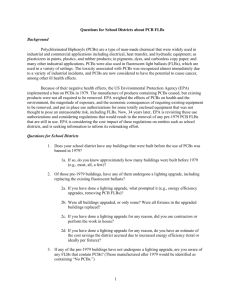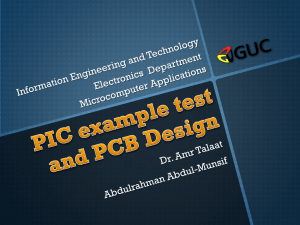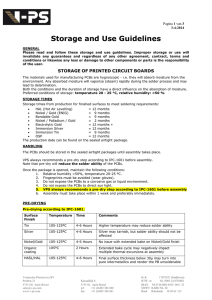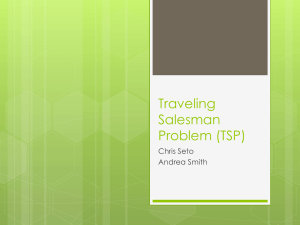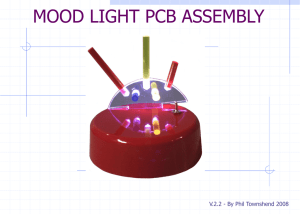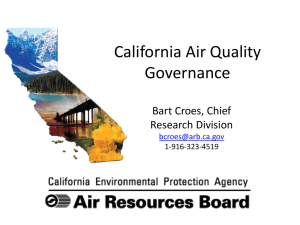PCB Use Authorizations
advertisement
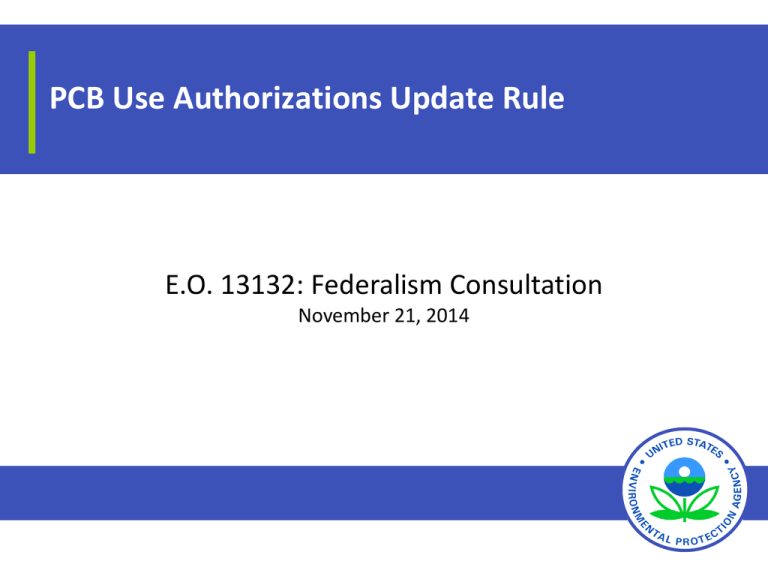
PCB Use Authorizations Update Rule E.O. 13132: Federalism Consultation November 21, 2014 Purpose and Agenda • Purpose: – To review the EPA’s requirements for Federalism consultation – To provide an overview of potential changes under consideration – Answer questions and get feedback • Agenda: – – – – Federalism Overview Background on PCB Use Authorizations (40 CFR part 761) Federalism Comments: Helpful Information Your Input on EPA Rule Options Under Consideration • • • • – Small Capacitors in Fluorescent Light Ballasts Transformers and Other Electrical Equipment Natural Gas Pipelines Contaminated Porous Surfaces Next Steps Office of Pollution Prevention and Toxics 1 Federalism Overview • • • • E.O. 13132 recognizes that – generally - issues that are not national in scope or significance often are most appropriately addressed by state and/or local governments However, for certain issues that may be national in scope, federal law or regulation sometimes must take precedence over existing state or local government law or regulation, or set new protective standards in cases where none exists The Order requires that Federal agencies consult with elected state and local government officials, or their representative national organizations, when developing regulations that have Federalism Implications EPA’s policy for implementing the Order defines regulations with Federalism Implications as those which: – – – • (1) preempt state or local law (2)(a) have state and/or local compliance costs of $25 million or more, nationally, in any one year (2)(b) have small government impacts likely to equal or exceed 1% of their annual revenues in any year This action may fall in the later category, (2)(a), as it may have national intergovernmental compliance costs of $25 million or more in any one year Office of Pollution Prevention and Toxics 2 Background on PCB Use Authorizations • Section 6(e) of the Toxic Substances Control Act banned the manufacture, processing, distribution in commerce, and use of polychlorinated biphenyls (PCBs), except when uses would pose no unreasonable risk of injury to health or the environment • On May 31, 1979, EPA promulgated regulations (at 40 CFR part 761) that established authorizations for certain ongoing uses of PCBs (44 FR 31514) • EPA has initiated this rulemaking to revise or end some authorized uses of PCBs, in part because the conditions under which they were authorized more than 30 years have changed Office of Pollution Prevention and Toxics 3 Background on PCB Use Authorizations • On April 7, 2010, EPA published an Advanced Notice of Proposed Rulemaking (ANPRM) entitled “Polychlorinated Biphenyls: Reassessment of Use Authorizations” – EPA requested comment on: • • • • The cost of conversion to non-PCB-containing equipment Disposal costs Use of substitutes The potential impact that a rulemaking might have on disparate communities and small business owners Office of Pollution Prevention and Toxics 4 Federalism Comments Helpful Information: • Consider how the options presented might create compliance costs for state and local governments • Provide specific examples of impacts and suggestions on how to mitigate these impacts • Provide cost data, if available • Suggest other relevant options, provide data on their costs and information on how to ensure compliance Office of Pollution Prevention and Toxics 5 Potentially Impacted Sectors • • • • • • • Utilities Natural gas transfer or distribution companies Schools Daycares Commercial building owners Governments or other entities with public buildings Other industries that have PCB electrical equipment Office of Pollution Prevention and Toxics 6 PCB Small Capacitors in Fluorescent Light Ballasts (FLBs) • PCB-containing small capacitors are authorized for use indefinitely and are present in FLBs manufactured before 1979 • We have learned from incidents in schools (e.g., NYC schools) that many of these PCB FLBs are still in use and often leak • A DOE energy efficiency rule is accelerating the removal of old FLBs nationwide Office of Pollution Prevention and Toxics 7 PCB Small Capacitors in Fluorescent Light Ballasts The PCB FLB Universe Preliminary Estimates Building Type Daycares Hospitals Primary and Secondary Schools Public Housing Other Public and Commercial Buildings Number 1 of Buildings that May Have PCBcontaining FLBs in 2015 2 <10,000 <1,000 Number of PCBcontaining FLBs in 2015 3 Number of Leaking PCBcontaining FLBs in 2015 4 Number of Leaks avoided through early removal (1/3/5 year compliance options) 500,000 800,000 300,000 500,000 <50,000/<3,000/0 <65,000/<5,000/0 <25,000 2.6 million 1.8 million 200,000/<15,000/0 100,000 1.3 million 900,000 100,000/<10,000/0 500,000 37.7 million 27.2 million 3.1 million/200,000/0 Pre-1980 buildings, fluorescent lighting, no major lighting retrofit based on 2003 Department of Energy survey data, Census data and NCES data 2 Estimated date for final rule promulgation 3 Based on 17% of total FLBs (PCB and non-PCB) 4 Based on 38% of total PCB-containing FLBs 1 Office of Pollution Prevention and Toxics 8 PCB Small Capacitors in Fluorescent Light Ballasts Potential Regulated Universe Options: 1. Daycare centers and primary and secondary schools 2. Daycare centers, primary and secondary schools, hospitals and public housing 3. All public and commercial buildings (includes Options 1 and 2 above and other buildings) Office of Pollution Prevention and Toxics 9 PCB Small Capacitors in Fluorescent Light Ballasts PCB FLB Option I: Revoke the use authorization for PCB small capacitors in FLBs* a) • b) • Phase-out the use of PCB FLBs in 1 year 1. Require signed statement based either on records that building has no PCB FLBs for exemption or inspection of subset of FLBs to determine presence of PCBs for inclusion Cost Range**: $4.0 - $62.7 million Phase-out the use of PCB FLBs in 3 or 5 years, and 1. Require inspection of all FLBs in 1 year to find leaking FLBs and require publicly available PCB FLB management plan for replacement Cost Range: $8.6 - $132.5 million 2. • Require inspection of all FLBs in 1 year to find leaking FLBs and periodic surveillance (e.g. every 6 months) and require publicly available PCB FLB management plan for replacement Cost Range: $10.0- $158.1 million 3. • No specific inspection or periodic surveillance required and require publicly available PCB FLB management plan for replacement Cost Range: $ 0. 0 - $41.1 million NOTE: Cost ranges are dependent on the regulated universe chosen (e.g., schools, commercial bldgs., etc.) *For 1 and 3 year options, consider providing a one-time extension provision (requiring justification) for entities that are not able to meet the phase-out requirement Office of Pollution Prevention and Toxics 10 PCB Small Capacitors in Fluorescent Light Ballasts PCB FLB Option II: Revise the use authorization for PCB small capacitors in FLBs to identify leaking PCB FLBs a) Require inspection of all FLBs in 1 year to find leaking FLBs and require publically available data on the location of leaking PCB FLBs Cost Range: $9.8 - $148 million b) Require inspection of all FLBs for presence of PCBs and whether leaking in 1 year and require publically available data on all PCB FLB locations including whether they are leaking Cost Range: $9.8 - $148 million NOTE**: Cost ranges are dependent of regulated universe chosen (e.g., schools, commercial bldgs, etc.) Office of Pollution Prevention and Toxics 11 How This Could Affect a Hypothetical School • Unit Costs – Inspection: $5.19 / fixture (based on $17.29 x 2 janitors x 9 minutes per fixture) – Disposal: $8.36 / leaking ballast and $3.23 / non-leaking ballast (including drums and shipping costs) – Replacement: $168.23 / fixture with leaking ballast(s) and $75.00 / fixture without leaking ballast(s) (with parts and labor included) • Using these assumptions, up-front costs for a hypothetical school with 75,000 square feet would range from $17,032 $77,114 (accounting for one year’s worth of energy savings) Office of Pollution Prevention and Toxics 12 PCB Small Capacitors in Fluorescent Light Ballasts • Questions – Do you have information regarding the degree to which school building(s) or public or commercial buildings in the United States (built before 1979) have FLBs that contain polychorinated biphenyls PCBs? – Do you have information regarding the degree to which school building(s) or public or commercial buildings in the United States (built before 1979) have performed lighting efficiency upgrades? – Do you have information pertaining to how local education agencies (e.g., school districts) or owners of public or commercial buildings have funded lighting retrofits (especially where PCB-containing light ballasts were removed)? Office of Pollution Prevention and Toxics 13 PCB Small Capacitors in Fluorescent Light Ballasts • Questions (continued) – Do you have information pertaining to either the process or the length of time it takes for local education agencies (e.g., school districts) or owners of public or commercial buildings to: • • • • • 1) inspect lighting systems for PCB-containing FLBs; 2) request funding to perform lighting retrofits and remove PCB-containing FLBs; 3) acquire funding to perform such retrofits; 4) plan the specific retrofits; and 5) complete the retrofits of lighting systems? Office of Pollution Prevention and Toxics 14 Transformers and Other Electrical Equipment • PCB transformers (>500 ppm) are the largest remaining reservoir of liquid PCBs in use – Approximately 80,000 remain in use • Approximately 800,000 PCB-contaminated transformers (50 to <500 ppm) remain in use • Industry commenters asserted that all PCB transformers and PCBcontaminated transformers will be disposed of by 2030 through attrition and voluntary replacement efforts • PCB are also authorized for use in other electrical equipment (e.g., switches, voltage regulators, circuit breakers, large capacitors, electromagnets, rectifiers, reclosers, cable and railroad transformers) – Little if any of this equipment still exists or currently contains PCBs Office of Pollution Prevention and Toxics 15 Transformers and Other Electrical Equipment Options: PCB transformers (>500 ppm) 1. Revoke use authorization for known and will-be-known PCB transformers in 5, 10, or 15 years - Costs: 5 yrs - $500K, 10 yrs – $20K, 15 yrs - $0.0 2. Disallow storage for reuse of PCB transformers 1 year from effective date - Costs: 1 yr -$900K, 2 yrs - $600K, 5 yrs - $200K, 10 yrs - $20K 3. Require transformer owners who dispose of or reclassify to < 50 ppm to deregister them from our database via e-reporting - Cost: (same as registering: 15 mins/$12 per report): $1.4K Office of Pollution Prevention and Toxics 16 Transformers and Other Electrical Equipment Options: PCB-contaminated (>50-499 ppm) transformers 1. Revoke use authorization or require reclassification within 5, 10, or 15 years - Costs: 5 yrs - $900K, 10 yrs - $40 K, 15 yrs - $0.0 2. Disallow servicing except to reclassify (<50 ppm) effective immediately or within 5 or 10 years after effective date - Costs: effect. Immed. - $8M, 5 yrs - $900K, 10 yrs - $40K 3. Revoke storage for reuse allowance in 1, 2, 5, or 10 years after effective date -Costs: 1 yr - $114.7M, 5 yrs - $76.6M, 10 yrs - $900K 4. Amend 761.180(b) to require annual reporting of the number disposed - Cost: (15 mins/$12 per transformer): $600K Office of Pollution Prevention and Toxics 17 Transformers and Other Electrical Equipment • Questions: – To your knowledge, do state and local governments own any PCB electrical equipment? If so, how prevalent is this equipment? – To what extent is this equipment being taken out of service (disposed of, reclassified, sold)? Is this being done by attrition, or as part of a removal (phase-out) program? – Do you store any of this equipment for reuse? – If you retain inventories of PCB electrical equipment, why (given that new equipment is more energy efficient, can better handle the current electrical loads, and that PCB spills can be costly to cleanup)? – What effect would a 2015, 2020, 2025, or 2030 phase out date have on state and local governments that own PCB electrical equipment? How much lead time is required? Office of Pollution Prevention and Toxics 18 Natural Gas Pipelines • Subject to certain requirements, EPA has authorized: – The use and reuse of PCBs in natural gas pipeline systems – The use and reuse of PCB-contaminated natural gas pipe and appurtenances • PCBs still contaminate many systems and the original 1998 regulations have deficiencies • EPA is aware of several instances of PCBs being discovered in customers meters and beyond Office of Pollution Prevention and Toxics 19 Natural Gas Pipelines Options: Release Reporting and Response Options: 1. 2. Require e-reporting to EPA regions and/or the affected/ potentially affected customer(s) of releases of PCBs ≥50 ppm to customer meters and appurtenances Upon request develop and submit to EPA regions remediation plans for such releases General Reporting Option: • Require e-reporting to EPA regions of all discoveries of PCBs ≥50 ppm Office of Pollution Prevention and Toxics 20 Natural Gas Pipelines Options: General System-Wide Reduction Measures Option: • Require one time sampling of all pre-1978 compressors within 1 year of rule, unless owners can provide historical data from prior sampling Use Authorization Changes for Sampling Option: • Modify 761,30(i)(1)(iii)(B) to explicitly require individual as opposed to batch sampling of organic liquids removed from natural gas systems for ≥ 50 ppm PCBs Office of Pollution Prevention and Toxics 21 Natural Gas Pipelines • Questions – Would state and local governments anticipate any direct compliance costs associated with the options EPA is considering? – If so, what would those compliance costs be? Are there ways to mitigate them? Office of Pollution Prevention and Toxics 22 Contaminated Porous Surfaces • Current regulation (§761.30(p)) allows the ongoing use of concrete and other porous surfaces contaminated by spills of liquid PCBs regulated for disposal – Spilled PCBs may be left in place if surface is covered and labeled • Questions – To your knowledge, do state and local governments utilize this use authorization? Office of Pollution Prevention and Toxics 23 Next Steps • Do you have any additional information that EPA should be aware of? – If so, please provide. • Do you have any other approaches that you would like EPA to consider? • Comments will be due to EPA in approximately 8 weeks, on January 16, 2014 • Please send written comments to: Simons.Tom@epa.gov and copy Hanson.Andrew@epa.gov • Anticipated date for proposed rule: late next year Office of Pollution Prevention and Toxics 24 Questions and Comments Thank you! • Project Contact: Tom Simons (202) 566-0517 Simons.Tom@epa.gov • Federalism Contact: Andrew Hanson (202)564-3664 Hanson.Andrew@epa.gov Office of Pollution Prevention and Toxics 25
